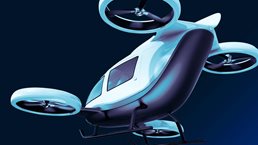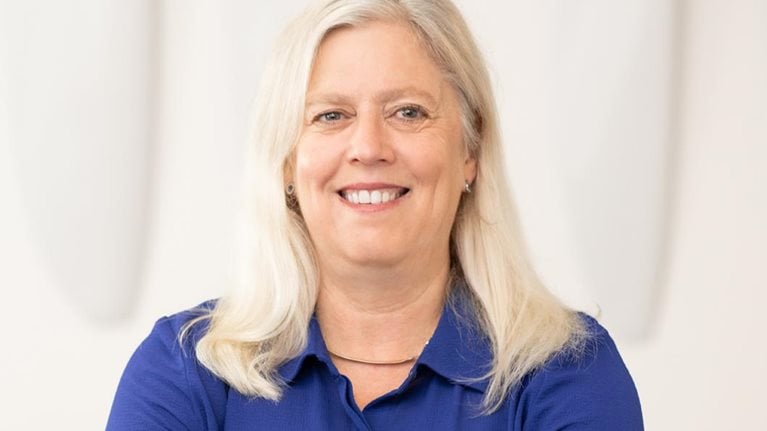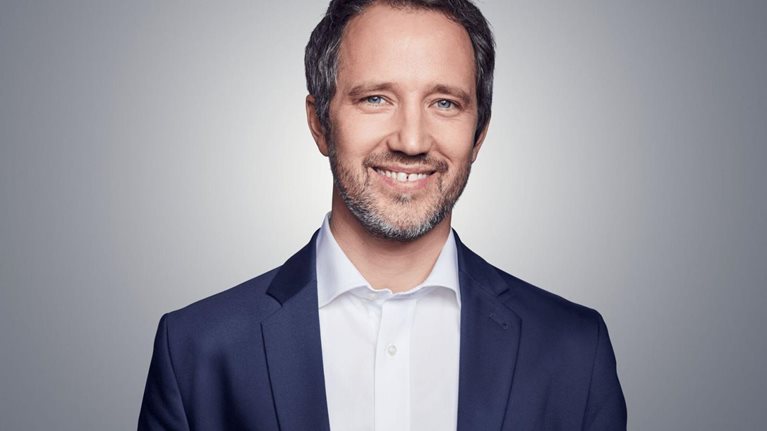He didn’t expect aircraft development to cost a billion dollars. When Daniel Wiegand and his team at German aviation company Lilium first set out to make electric flying vehicles a reality, he was “a bit naive” about the cost and scope of such an undertaking. Much has happened since Wiegand and three other graduates of the Technical University of Munich founded Lilium in 2015. Today, Lilium is one of more than 250 entities developing electric vertical takeoff and landing (eVTOL) aircraft.
The advanced air mobility (AAM) industry has been hot lately, attracting more than $5.4 billion in investment in just the first nine months of 2021. Lilium became a publicly traded company in September. Wiegand says that the company plans to offer its first commercial flights to consumers in 2024; locations announced to date include Florida and parts of Germany and Brazil. Unlike many AAM players, which are focusing on urban air mobility—flying passengers and cargo to and from various areas within a city—Lilium is instead gearing up to offer a regional intercity service. Its website describes a world in which a future trip from San Francisco to Lake Tahoe takes under an hour by eVTOL aircraft, compared with almost four hours by car. Traveling from Zurich to St. Moritz, a two-and-a-half-hour drive, would take 29 minutes by air. Wiegand calls it “expanding the radius of life.”
Wiegand recently spoke with McKinsey’s Robin Riedel in Lilium’s hangar near Munich, where the company is constantly testing and refining the technology for its sleek, black-and-white seven-seater electric jet. Edited excerpts of their conversation follow.
Robin Riedel: Let’s start with the name of your company. Why is it called Lilium?
Daniel Wiegand: Otto Lilienthal is believed to be the inventor of aircraft in Germany. We took the Latin version of his second name, which means “lily.” He had a dream that, one day, instead of walking or using horse carriages, we would be flying through the air as our main means of travel. His dream fits pretty well with what we’re doing here at Lilium.
Robin Riedel: When do you think that dream will become a reality? Paint us a picture of what AAM will look like in the coming years and who will be using it.
Daniel Wiegand: I believe 2025 will be the launch phase of this industry, and by 2030 it will really be ramping up—that’s when you will see exponential growth, and eVTOL aircraft will become a part of everyday life. I expect that there will be many applications of this new technology. On the ground today, there’s everything from sports cars to trucks to buses. We will see something similar in the air: there will be eVTOL aircraft used on intercity shuttle routes, which is what Lilium is focused on right now. There will be sightseeing applications, taxi applications, cargo applications, and so on. We’ll see many different products and business models.
Robin Riedel: Will AAM reduce private car ownership?
Daniel Wiegand: Maybe a little. I think what it will truly change is the perception of time and distance. Imagine how different our lives would be today if we only had bicycles. We would have to live very close to our workplace, close to our friends, close to where we want to shop, et cetera. For short trips like these, a bicycle is roughly five times slower than a car.
An eVTOL is five times faster than a car. So think about how that would change things: we’ll see different pricing of real estate, for example. We’ll be able to live in the countryside and work in the city. What we like to say at Lilium is, this is a different radius of life. Essentially, the radius of our life expands with the speed at which we can travel—especially the speed at which we can do everyday travel.

The future of air mobility: Electric aircraft and flying taxis
The passenger experience
Robin Riedel: What will it feel like to ride on a Lilium Jet in five or ten years? Will it be just like flying in an airplane?
Daniel Wiegand: It will be safe, fast, and convenient. We’re looking at the aircraft not only as a product—we want to get the whole experience right, from the check-in process to actually getting on and off the aircraft. That means we, along with our infrastructure partners, like Ferrovial [the Spanish transportation infrastructure company], are working hard to make the entire journey seamless, from the first mile to the last.
The Lilium Jet has a spacious cabin. Our jet technology has a very low vibration, so it will be a comfortable ride, with low noise emissions. We want to deliver an experience that corresponds to what customers expect in the 21st century.
It’s also important to us that all of this is connected within a network—so we’re not only looking at the Lilium flight itself but also at embedding these flights into a bigger transportation network that covers an entire country. That means being connected to ground transportation—taxis, car services, trains—and all the way up to the big airlines, to which Lilium flights would act as feeder flights.
One thing I’d like to clear up is that Lilium won’t be an air-taxi service—at least not in the first ten years or so. Instead, we will be providing scheduled shuttle services from one city center to another. The business model is comparable to a high-speed train that connects two cities.
Robin Riedel: You said the aircraft will have “low noise emissions.” Noise is obviously a big concern for consumers—not just passengers but anyone who lives or works near takeoff and landing points. How has Lilium been able to solve the noise problem?
Daniel Wiegand: We use ducted electric vectored thrust [DEVT] technology. Our jets have ducted fan engines powered by electric motors. Acoustic liners around the fans capture and dissipate much of the noise. Our tests show that the perceived noise level of the jet, when it’s in its initial hover phase, is about the same as a dishwasher from 100 meters away. And when it’s cruising, you will barely hear it at all.
We believe low noise emissions is one of the key enablers for the entire eVTOL sector. Low noise is crucial to community acceptance and to accessing the spots in urban environments where we want to take off and land. Helicopters have been able to do vertical takeoff and landing for a very long time, but they are very noisy and costly. The eVTOL industry won’t be truly successful unless it solves those two fundamental issues.
Affordability and autonomy
Robin Riedel: So DEVT is your solution to the noise issue. What about the affordability issue? When will most people be able to afford a Lilium flight?
Daniel Wiegand: Initially, we’re expecting that the price will be around $2.25 per passenger mile. Over the medium or long term—with higher-capacity autonomous aircraft and lower-cost infrastructure—the price will be comparable to high-speed trains or other ground-based transportation.
From the start, it’s been Lilium’s mission to create a high-speed transportation system that is affordable for everyone. All our decisions have been made with this goal in mind. The early adopters will most likely be businesspeople, partly because price points will be higher in the early phases. But we think that eVTOL aircraft will eventually become a standard means of transportation for our whole society. In the 2030-to-2045 timeframe, using an eVTOL aircraft will be as normal as driving a car is today.
Robin Riedel: Where exactly will all these eVTOL aircraft take off and land?
Daniel Wiegand: We’ve designed an infrastructure—and an aircraft—that meets current regulations while also allowing a very high-throughput eVTOL service. We’re determined to achieve high throughput because that was the feedback from our partners and customers.They said, “We don’t want just 20 people coming in per day. We want hundreds, maybe thousands, per hour.”
The infrastructure looks quite simple: each “vertiport” has at least one helicopter pad and multiple gates—typically six to ten—where passengers can board while the aircraft is charging. All these places are connected via a central taxiway. There will typically be some kind of lounge where passengers can check in to their flight on their phones and get some food and beverages. But we envision people flowing through this infrastructure quickly—not spending a lot of time there like we do today in airports.
This can be one of the big advantages of the eVTOL industry: making the airport experience very different from what we know today. We’re all annoyed at how much time we spend on the ground and how little time we spend in the air. With eVTOLs, we can have small, distributed, efficient vertiports. It will take two or three minutes—not an hour or more—to get from a car into an airplane.
By 2030, there will probably be a lot of infrastructure created in a very distributed way, from private garages and vertiports in small villages to hotel rooftops and downtown vertiports in big cities. Beyond 2030, Lilium could potentially shift from providing shuttle services only for larger groups of people to also providing on-demand services for individuals, where you can maybe take a two-seater airplane from a vertiport next to your house to a village somewhere. Again, with autonomous aircraft and low-cost infrastructure, we could get to the price points and throughput that will make sense for an on-demand air-taxi business model.
Robin Riedel: So the price will drop when the vehicles become autonomous—but Lilium flights will be piloted at first, right? How do you expect that to evolve?
Daniel Wiegand: Yes, Lilium will initially have pilots on board. Each of our pilots will hold a commercial pilot license and get the full training of an airline pilot, plus an additional “type rating,” or certification, for the specifics of the Lilium Jet.
Over time, we’ll develop autonomous technologies. People often ask, “What will happen to the pilots training on these aircraft today?” We think we’ll need them for a very long time. The pilot will be on the ground, acting as a supervisor of five, ten, 20, or 30 autonomous aircraft flying at the same time. So we’re envisioning a gradual shift from a fully piloted service to a more or less autonomous service. As we shift to autonomy, the number of aircraft that one pilot can operate will simply increase.
Making aviation more sustainable
Robin Riedel: What about sustainability? Is it good for the environment to have so many Lilium jets in the air?
Daniel Wiegand: Sustainability is part of our core mission. From day one, we made our aircraft all electric and battery powered. We didn’t even go for any hydrogen options, because hydrogen consumes roughly three times more primary energy to make the same trip.
The eVTOL sector is also serving as a catalyst for the entire aviation industry to become more environmentally friendly. Lilium aircraft are jets—just like the airplanes flying in the air today—so the technologies and processes we’re using aren’t just for eVTOL aircraft. They can also be used for “normal” electric jets. The regulation to certify batteries for our aircraft, for example, can be used to certify batteries for other electric jets. So, in this way, eVTOL is helping to bring sustainability into the wider aviation community.
Leadership lessons
Robin Riedel: You cofounded Lilium before you turned 30. What are some of the biggest leadership lessons you’ve learned as a young founder and CEO—and one who has been building not only a new company but a whole new industry?
Daniel Wiegand: One lesson that’s probably independent of this industry—it’s a lesson for founders—is that whenever something goes great in the company, it’s linked to your people. And whenever something isn’t going so well, it’s also linked to either your people or the structure in which you put them. It’s all about the people.
There have been challenges along the way, of course. One of the challenges we faced was that we were initially a bit naive about the scope and cost of developing something like this. I think our first estimate was for a smaller sports aircraft in the $50 million to $100 million range. But now that we’re designing against the same safety standards as an airline, we’ve discovered that the development cost will be $1 billion or more.
With this recognition comes the need for more fundraising, which means you need to spend much more laser-focused time on making sure that you have a compelling business case. Otherwise, the whole thing will just fall apart.
Thankfully, at Lilium, we started early. More than four years ago, we began looking systematically into the business case—the costs, what customers expect from such a service, and so on. One thing we found, for example, was that an air-mobility service needs to reduce passengers’ travel time by at least half an hour. Otherwise, they won’t think it’s worth the trouble to switch from a car to an aircraft and back to a car; they’ll just take the longer car trip.
Robin Riedel: It’s an exciting time in AAM, and there are now so many companies hoping to compete in this space. How do you think the AAM ecosystem will evolve? Is there room for everyone?
Daniel Wiegand: We think there’s room for at least five to ten players—both big companies and independent companies—because the demand in the medium and long term is going to be so high that one company alone would never be able to meet it. We’re excited that there’s a whole sector growing up around us, because when there’s an ecosystem, investors are more comfortable with investing. Your partners are more comfortable because they know that if you fail, someone else can take your place. And there is more infrastructure being built, more supply-chain developments happening, more politicians pushing for state funding. If we were the only company in the entire sector, most of these things would not happen, and we would have a very hard time making progress. So we welcome the competition.
Comments and opinions expressed by interviewees are their own and do not represent or reflect the opinions, policies, or positions of McKinsey & Company or have its endorsement.



